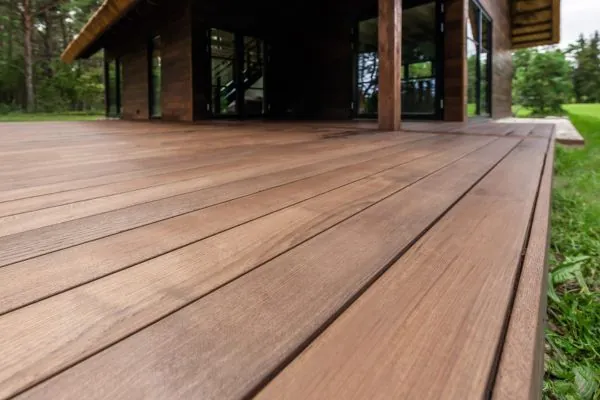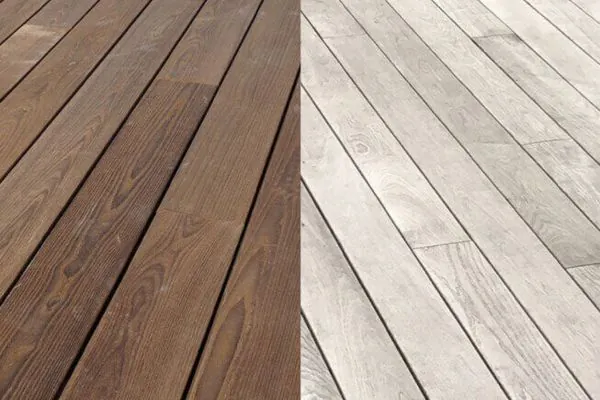When building or upgrading a deck, choosing the suitable material is crucial. In MetroWest MA, where the weather can be unpredictable, thermal wood is an ideal choice. If you want a deck that combines durability, sustainability, and beauty, thermal lumber should be at the top of your list. This eco-friendly option undergoes heat treatment, giving it superior resistance to moisture, decay, and insects, which is essential in New England’s harsh climate.
Beyond its functional benefits, thermal wood offers a rich, natural look that enhances any outdoor space. Whether you are looking to build a new deck or replace an old one, thermal wood perfectly balances performance and aesthetic appeal. This article explores why thermal wood is the best choice for your MetroWest deck building and how it can elevate your outdoor living experience.
Ready to learn more? Let’s start!
What is Thermally Modified Wood?
Thermally modified wood, often called thermal wood, has undergone a heat treatment process to improve its durability and resistance to natural elements. This process transforms the wood at the cellular level, making it less absorbent and more stable in extreme weather conditions. This environmentally friendly modification boosts the wood’s performance and enhances its natural beauty, making it a preferred choice for decking and other outdoor structures.
Thermal Modification Process
The thermal modification involves heating the wood to high temperatures, typically between 180°C and 230°C, without using chemicals. During this process, the wood’s moisture is removed, and its structure is altered, resulting in increased resistance to rot, decay, and insect infestation. The heat also reduces the wood’s ability to absorb water, which helps prevent swelling, shrinking, and warping. This treatment essentially ‘locks in’ the wood’s form, making it more dimensionally stable. As a result, thermally modified wood becomes more durable and requires less maintenance, ideal for decks exposed to harsh weather.
Origins and Development of Thermally Modified Wood
Thermally treated wood decking dates back centuries, with early civilizations using heat treatments to preserve wood. However, modern thermal modification techniques began in Europe in the 1990s, where they were refined into the eco-friendly processes used today. European researchers developed methods to heat wood in oxygen-free environments to avoid combustion, discovering that this enhanced the wood’s durability without harmful chemicals. The popularity of thermally modified timber increased across Europe. It later spread to the U.S., becoming a go-to material for eco-conscious builders needing sustainable yet durable wood options.
Technological Advances in Modification Processes
Technological advancements have recently improved the thermal modification process, making it even more efficient and effective. Modern kilns have precise temperature controls and oxygen-reduction systems, ensuring uniform treatment without damaging the wood. These advances allow manufacturers to produce thermally modified timber in various species, expanding the options available for builders and homeowners. Today, thermally modified wood is durable and visually appealing, making it a top choice for outdoor projects. The continued advance in building materials means homes and businesses are stronger and better protected.
Benefits of Using Thermally Modified Wood for Decking
Thermally modified wood offers numerous benefits, making it an excellent choice for decking, particularly in areas like MetroWest MA, where weather conditions can be harsh. Its unique properties offer advantages such as increased durability, enhanced stability, and a beautiful, natural appearance that can elevate the look of any outdoor space.
Below, we explore some key benefits of using thermally modified wood for your decking.
Resistance to Decay
One of thermally modified wood’s most significant benefits is its decay resistance. The heat treatment alters the wood’s composition, making it less vulnerable to fungi, rot, and insect infestations. Since the wood becomes less absorbent, it does not retain the moisture that typically leads to decay. This increased resistance is crucial for decks constantly exposed to rain, humidity, and temperature changes.
Increased Dimensional Stability
Thermally modified wood offers excellent dimensional stability, meaning it’s less likely to warp, crack, or shrink over time. The high-temperature treatment removes much of the wood’s moisture content, which is a primary cause of degradation in natural wood. This stability is especially needed where environmental changes can lead to warping or splitting. Thermally modified wood gives a stable, solid deck that maintains its structural integrity season after season.
Enhanced Appearance
Beyond its durability, thermally modified wood is prized for its aesthetic appeal. The heat treatment process deepens the wood’s natural color, giving it a rich, warm tone that enhances any outdoor setting. Unlike chemically treated wood, thermally modified timber retains its organic beauty with a smooth finish highlighting natural grain patterns. This improved appearance makes it a popular choice for homeowners looking to add visual appeal to their decks.
Applications of Thermally Modified Wood in Outdoor Spaces
Thermally modified wood has become increasingly popular for outdoor applications due to its durability, resistance to weather, and low maintenance. Its versatility makes it an excellent material not only for decking but also for a variety of outdoor structures. Whether you are planning a new deck, porch, or other outdoor features, thermally modified wood provides both beauty and functionality.
Decking
Thermally modified wood is ideal for decking because it can withstand outdoor conditions while maintaining its structural integrity and appearance. The heat treatment process makes the wood highly resistant to moisture, preventing common issues like rot, mold, and warping. This durability mainly benefits decks in areas like MetroWest, MA, where the weather can fluctuate dramatically.
Porch
Porches often endure varying humidity levels, sunlight, and foot traffic. Thermally modified wood’s enhanced durability helps with this. Its moisture resistance prevents cracking, swelling, and warping, ensuring the porch remains sturdy over time. Plus, the wood’s rich, natural appearance adds warmth and beauty to the outdoor space, creating an inviting entryway to any home.
Other Outdoor Structures
Beyond decking and porches, thermally modified wood can be used for various outdoor structures, such as pergolas, fences, and garden sheds. Its resistance to weather makes it a reliable option for structures that face constant exposure to rain, sunlight, and fluctuating temperatures. The wood’s natural beauty and smooth finish enhance the final aesthetic appeal.
Comparison with Other Decking Materials
When selecting a suitable decking material, it is essential to weigh the benefits of thermally modified wood against other popular options. Each material, traditional wood, composite, and PVC, offers distinct features, but thermally modified wood offers a unique combination of sustainability, durability, and natural beauty.
Against Traditional Wood
Thermally modified wood offers superior durability and resistance to the elements compared to traditional wood. Traditional wood can be prone to warping, rotting, and insect damage, especially when exposed to moisture. Thermally modified wood, however, undergoes a heat treatment process that enhances its resistance to decay, moisture, and insects.
Against Composite and PVC
One key difference between thermally modified wood, composite, and PVC is their natural appearance and eco-friendliness. Composite and PVC decking are manufactured materials often designed to mimic the look of wood, but they lack the authentic grain and warmth of real wood. This is a compromise property owners have to consider when choosing their wood material.
Why Choose Thermally Modified Wood for Your MetroWest MA Deck?
Choosing the right decking material is crucial for ensuring longevity and performance, especially in MetroWest, MA’s variable climate. Thermally modified wood is an excellent choice due to its durability, aesthetic appeal, and suitability for local conditions.
Local Availability and Supplied by Renowned Lumber Plus
Thanks to reputable suppliers, thermally modified wood is readily available in the MetroWest area. This local availability ensures that homeowners can access high-quality materials without delays or excessive shipping costs. Lumber Plus is known for its commitment to providing top-notch products, making it a reliable source for your decking needs.
Suitability to Local Climate
The unique climate of MetroWest MA, with its cold winters and humid summers, requires a decking material that can withstand these extremes. Thermally modified wood is well-suited to these conditions, as its heat-treated process enhances its resistance to moisture, temperature fluctuations, and decay. This makes it a durable and low-maintenance choice for decks in this region.
Conclusion
In conclusion, thermally modified wood offers an exceptional choice for decking in MetroWest, MA, thanks to its superior durability, aesthetic appeal, and adaptability to local climate conditions. Its resistance to decay, enhanced dimensional stability, and natural beauty make it a standout option compared to traditional wood and synthetic materials.
With local availability through trusted suppliers like Lumber Plus, you can enjoy a long-lasting, low-maintenance deck that meets and exceeds your expectations. Investing in thermally modified wood ensures a deck that will enhance your outdoor living space for years. Call the local pros in decks today to get started!







